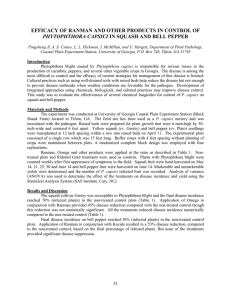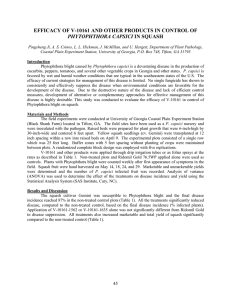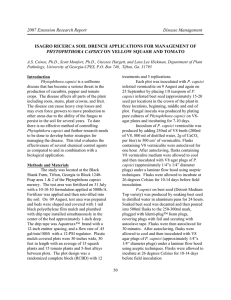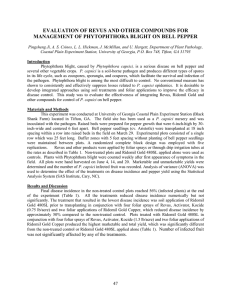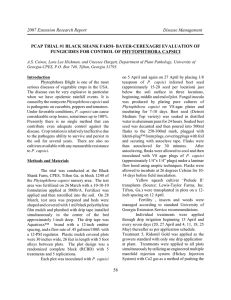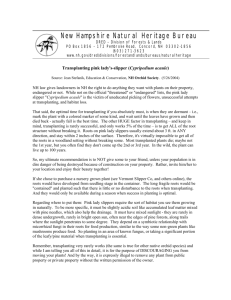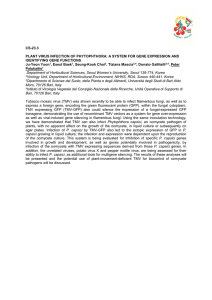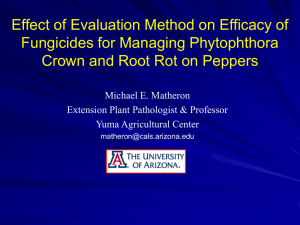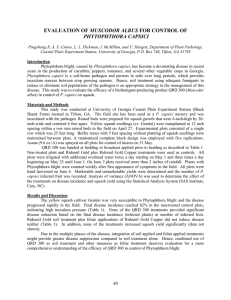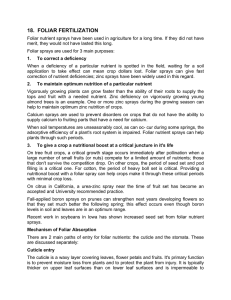2007 Extension Research Report Disease Management PHYTOPHTHORA CAPSICI
advertisement
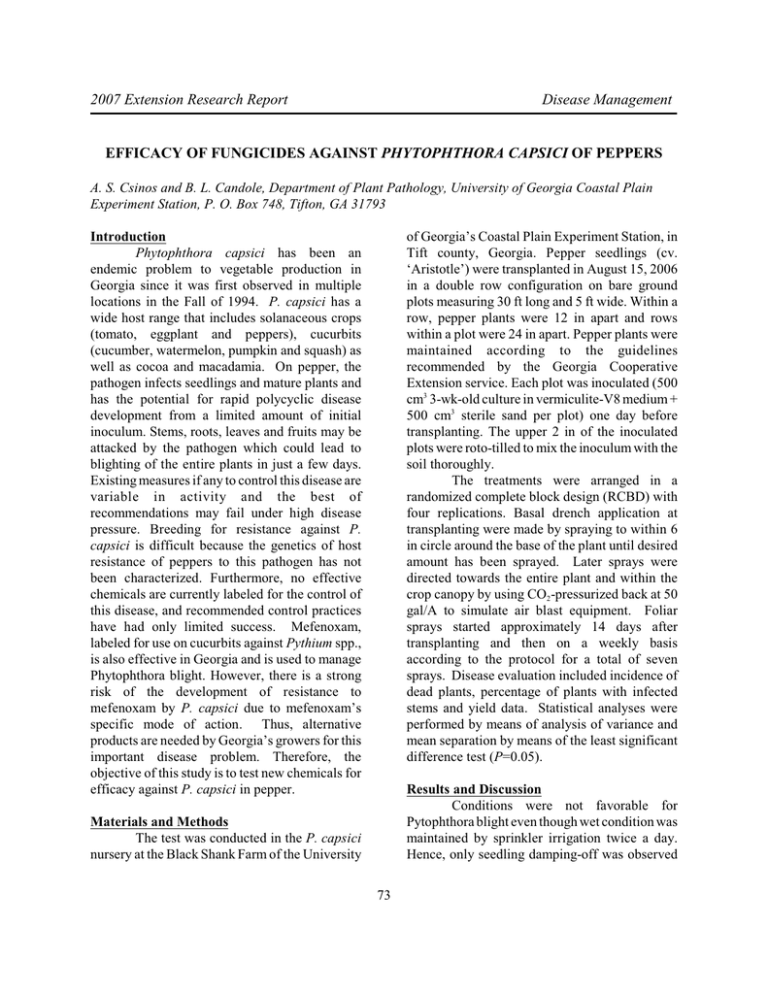
2007 Extension Research Report Disease Management EFFICACY OF FUNGICIDES AGAINST PHYTOPHTHORA CAPSICI OF PEPPERS A. S. Csinos and B. L. Candole, Department of Plant Pathology, University of Georgia Coastal Plain Experiment Station, P. O. Box 748, Tifton, GA 31793 of Georgia’s Coastal Plain Experiment Station, in Tift county, Georgia. Pepper seedlings (cv. ‘Aristotle’) were transplanted in August 15, 2006 in a double row configuration on bare ground plots measuring 30 ft long and 5 ft wide. Within a row, pepper plants were 12 in apart and rows within a plot were 24 in apart. Pepper plants were maintained according to the guidelines recommended by the Georgia Cooperative Extension service. Each plot was inoculated (500 cm3 3-wk-old culture in vermiculite-V8 medium + 500 cm3 sterile sand per plot) one day before transplanting. The upper 2 in of the inoculated plots were roto-tilled to mix the inoculum with the soil thoroughly. The treatments were arranged in a randomized complete block design (RCBD) with four replications. Basal drench application at transplanting were made by spraying to within 6 in circle around the base of the plant until desired amount has been sprayed. Later sprays were directed towards the entire plant and within the crop canopy by using CO2 -pressurized back at 50 gal/A to simulate air blast equipment. Foliar sprays started approximately 14 days after transplanting and then on a weekly basis according to the protocol for a total of seven sprays. Disease evaluation included incidence of dead plants, percentage of plants with infected stems and yield data. Statistical analyses were performed by means of analysis of variance and mean separation by means of the least significant difference test (P=0.05). Introduction Phytophthora capsici has been an endemic problem to vegetable production in Georgia since it was first observed in multiple locations in the Fall of 1994. P. capsici has a wide host range that includes solanaceous crops (tomato, eggplant and peppers), cucurbits (cucumber, watermelon, pumpkin and squash) as well as cocoa and macadamia. On pepper, the pathogen infects seedlings and mature plants and has the potential for rapid polycyclic disease development from a limited amount of initial inoculum. Stems, roots, leaves and fruits may be attacked by the pathogen which could lead to blighting of the entire plants in just a few days. Existing measures if any to control this disease are variable in activity and the best of recommendations may fail under high disease pressure. Breeding for resistance against P. capsici is difficult because the genetics of host resistance of peppers to this pathogen has not been characterized. Furthermore, no effective chemicals are currently labeled for the control of this disease, and recommended control practices have had only limited success. Mefenoxam, labeled for use on cucurbits against Pythium spp., is also effective in Georgia and is used to manage Phytophthora blight. However, there is a strong risk of the development of resistance to mefenoxam by P. capsici due to mefenoxam’s specific mode of action. Thus, alternative products are needed by Georgia’s growers for this important disease problem. Therefore, the objective of this study is to test new chemicals for efficacy against P. capsici in pepper. Results and Discussion Conditions were not favorable for Pytophthora blight even though wet condition was maintained by sprinkler irrigation twice a day. Hence, only seedling damping-off was observed Materials and Methods The test was conducted in the P. capsici nursery at the Black Shank Farm of the University 73 as early as one week after transplanting and plants with black stem lesions were observed late in the season. Except for V-10161 or Ranman, the percentage of dead plants and the disease incidence in terms of AUDPC were not significantly different than the untreated control or the Ridomil standard (Table 1). While the incidence of dead plants and AUDPC value in V10161-treated plants were the lowest, they also had the lowest yield among the eight treatments (Table 1). Furthermore. the incidence of dead plants and AUDPC values in V-10161-treated plants were significantly lower than the values in the untreated plants but the differences in yield between these two treatments were not significant. Due to the absence of significant differences among treatments, and between chemical treatments and the untreated control, the conclusion as to which of the test chemicals was the most effective against P. capsici is not warranted. 74 Table 1. The effect of selected chemicals on the incidence of dead plants due to Phytophthora capsici, areas under the disease progress curves (AUDPCs) and yield of pepper (cv. ‘Aristotle’). AUDPCb Total fruit yield (t/ha) 14.2 ab 1532 a 2.8 cd 2.5 bc 8.0 b 801 ab 3.4 bcd 2.8 abc 20.3 a 1275 ab 4.1 ab 3.9 ab 7.8 b 748 b 2.5 d 2.3 c Maestro 80 DF (Arysta/MANA) = 6 lb/A. Basal drenched at transplanting then foliar sprays. 11.3 ab 854 ab 4.1 abc 3.2 abc Folpan 80 WDG (Folpet, MANA) = 6 lb/A. Basal drenched at transplanting then foliar sprays. 13.5 ab 1096 ab 3.3 bcd 2.9 abc 10.5 ab 963 ab 3.7 abcd 3.5 abc Treatment Untreated Dead plants (%)a Marketable yield t/ha Ranman (Cyazofamid) = 2.75 fl oz/A. Basal drenched at transplanting. Raman + Silwet L-77 = 2.75 + 2 fl oz/A. Foliar sprays. SA-110201 10%SC (Sipcam) - 32 fl oz/A. Basal drenched at transplanting then foliar sprays. V10161 (Fluopicolide) = 40 g ai/A. Basal drenched at transplanting then foliar sprays. NOA 446510 250 SC (Mandipropramid) = 8 fl oz/A. Basal drenched at transplanting . NOA 446510 250 SC + Nonionic surfactant = 8 fl oz/A (0.125%). Foliar sprays. Ridomil Gold EC (Mefenoxam) = 1 pt/A. Preplant soil incorporation & drench/basal spray 30 days later. 13.9 ab 1003 ab 4.8 a 4.1 a Ridomil Gold/MZ (Mefenoxam) = 2.5 lbs/A. Foliar spray. Numbers are averages of 4 replicates. a Dead plants (%) = (number of dead plants/total number of plants) x 100. b AUDPC = n 3i = 1 (Xi+1 + Xi)(ti+1 -ti)/2, where Xi = disease incidence at the ith observation, ti = days at the ith observation, and n=total number of observations. Within a column, numbers followed by the same letters are not significantly different by LSD at p=0.05. 75
